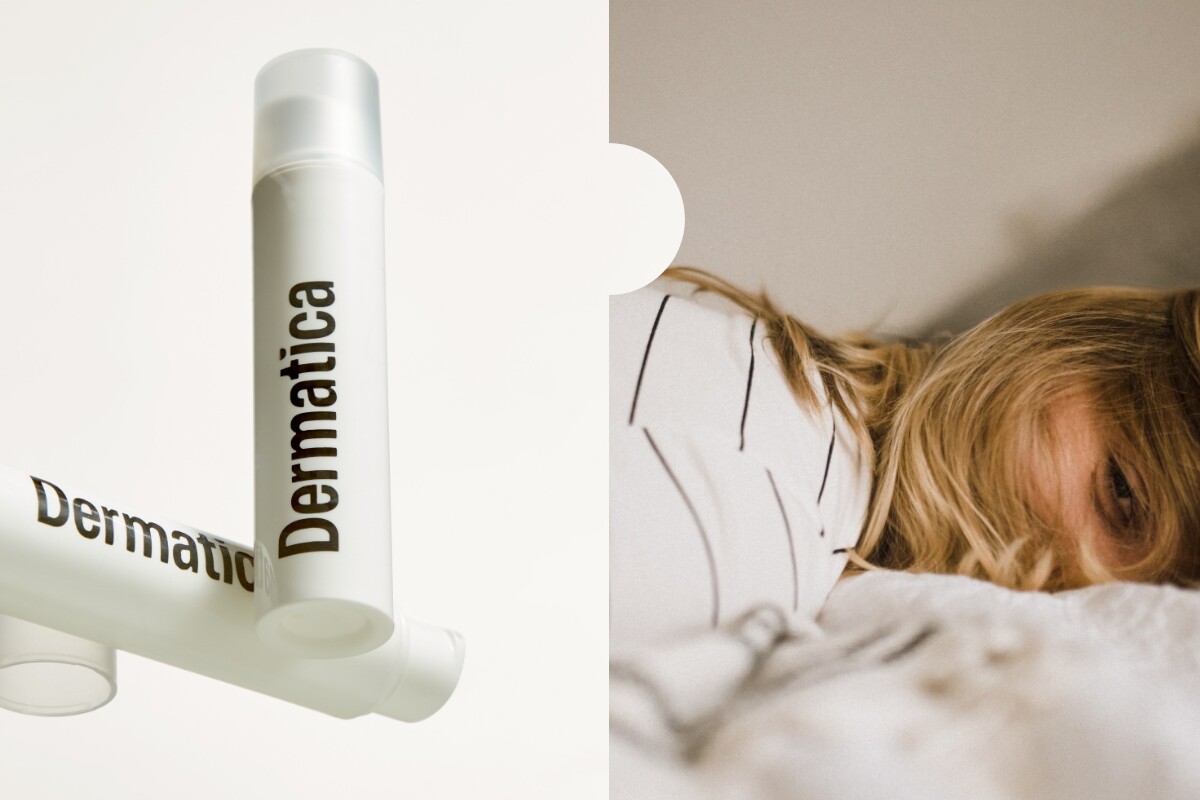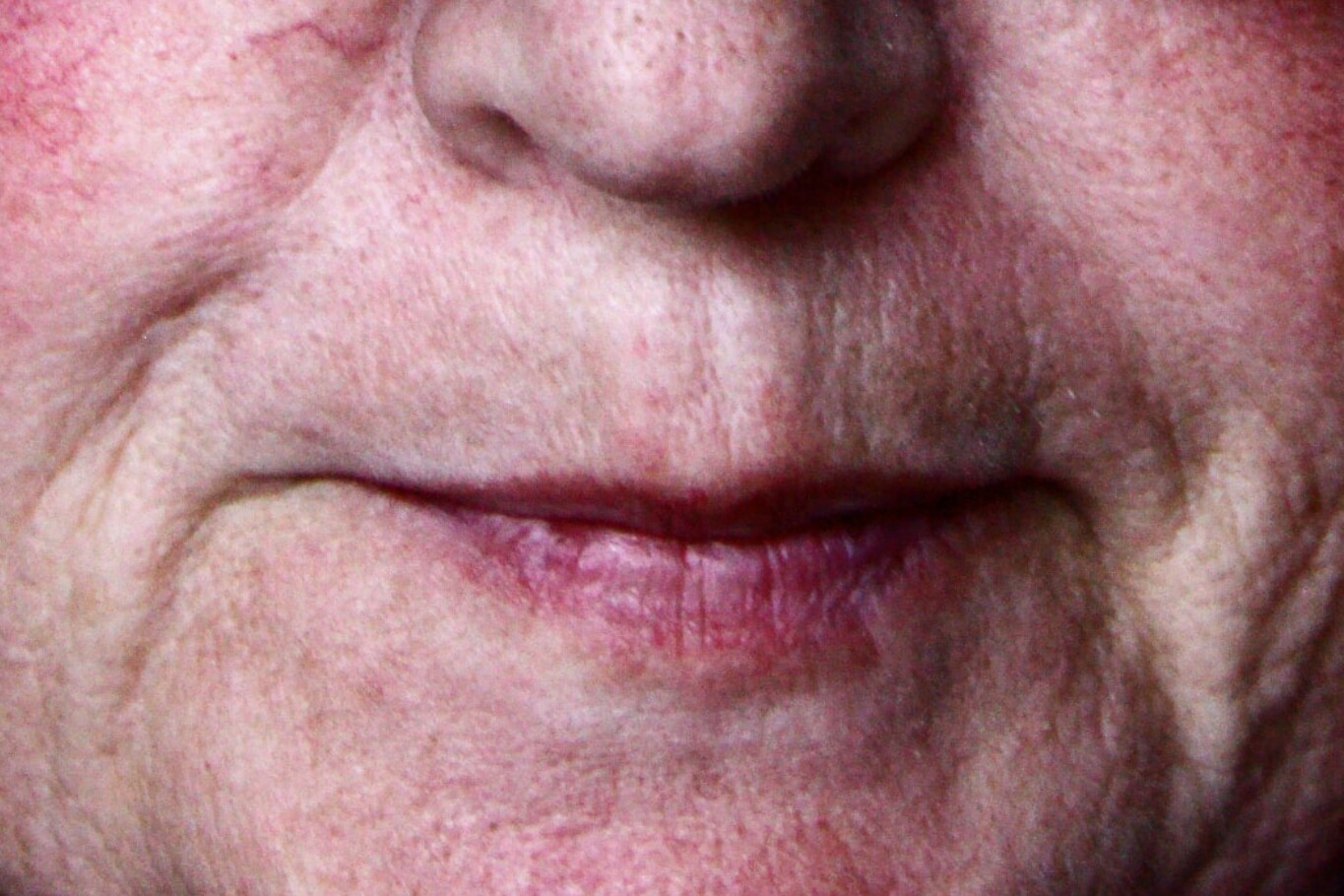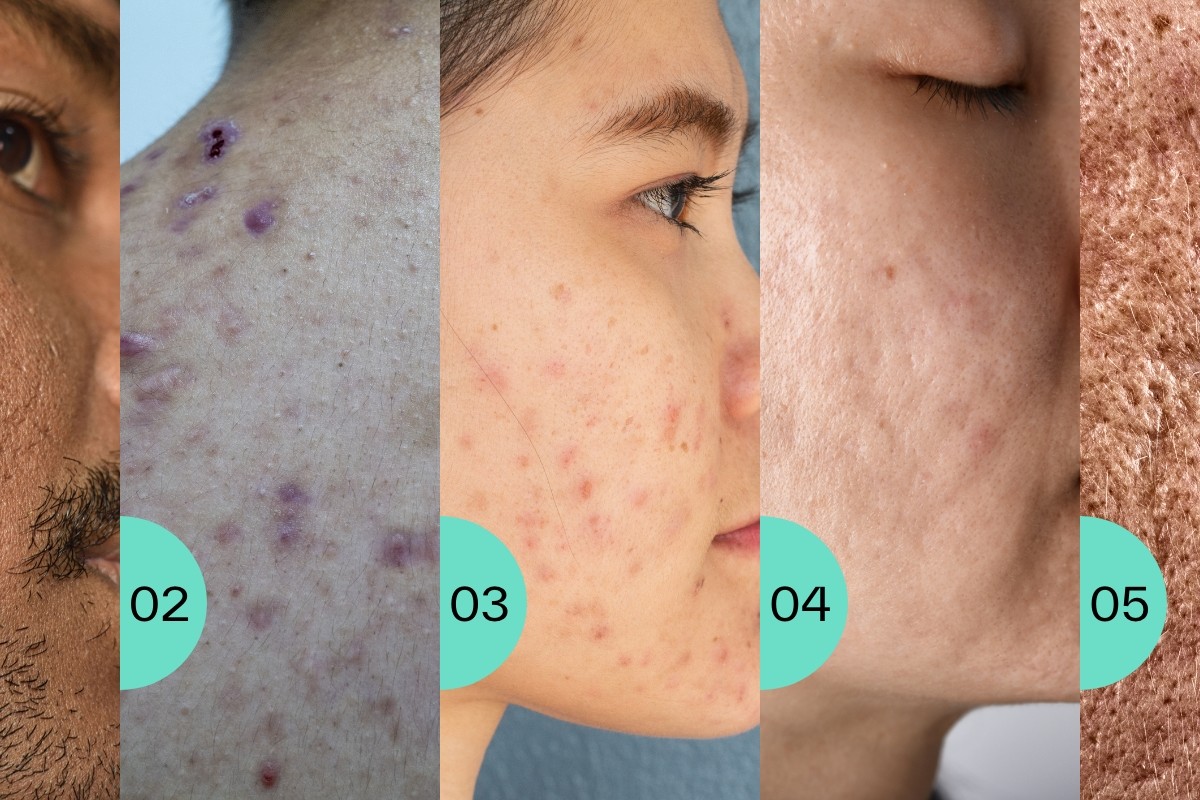First – congratulations! If you’re reading this, hopefully, you’ve achieved your skin goal.
And now, of course, you need to know how to maintain that clear-skinned glow and keep the blemishes at bay. Scroll to find out more.
How your formula cleared your skin
If you’ve been dealing with acne, you’ve probably been using topical retinoids, most likely adapalene or tretinoin.[1,2] These are powerful vitamin A derivatives applied directly to the affected areas of your skin.
Retinoids work by speeding up skin cell turnover, removing dead skin cells and preventing the build-up that clogs pores.[3] Your formula may also contain a bacteria-fighting ingredient, such as benzoyl peroxide or clindamycin.[4]
It may have taken a few weeks or months to get the results you’re after, but you’ll no doubt agree it was worth the wait. And now your skin is clear, you want it to stay that way.
Treatment, not cure
It’s important to remember that topical treatment is not necessarily a ‘cure’. The underlying issues that caused acne in the first place won’t necessarily have gone away. These could include increased oil production, skin bacteria, build-up of skin cells, and inflammation.[5]
Acne, especially in women, can persist into your 30s, 40s or beyond.[6] But, since you can’t know for sure that it won’t return, controlling your acne – and keeping it away – usually calls for an ongoing commitment to a good skincare routine.
Keep up the active treatment
Everyone’s skin is different. For the lucky ones, acne will clear and not come back. But relapses are common.
Your skincare expert will probably recommend that you keep using a retinoid formula.[7] So, for example, a 6 or 12-week course of daily treatment that has worked well might be followed by a less-frequent use of the same formulation.[8,9] Retinoids will continue to lighten pigmentation and improve the skin texture, which is often present due to the inflammatory process of the skin. Furthermore, they help to stimulate collagen production and reverse fine lines caused by UV radiation (photodamage) which will help improve the overall complexion!
Adapalene, either alone or combined with clindamycin, or benzoyl peroxide, is the most commonly used agent for maintenance treatment.[10] We also use other ingredients that help to fade blemishes, pigmentation and inflammation, such as azelaic acid and niacinamide. This is an effective acne treatment and might be especially beneficial if you have post-acne hyperpigmentation or scarring.[11]
What happens if I stop my treatment?
There’s a risk of your acne returning if you don’t stick with the active ingredients you’ve been prescribed. In one study among people whose acne improved with adapalene and clindamycin, 92% had an increase in lesions at a 2-year follow-up if they hadn’t continued to use adapalene.[12]
It’s a good idea to review your regimen again around three months into the maintenance phase to see how things are going.[13] Our Dermatology Team will review your progress every few months to see how you’re getting on and adjust treatment accordingly. They’re always here beforehand as well if you have any questions.
Stick to a simple skincare routine
To reduce the risk of breakouts and minimise irritation, it’s best to stick with a simple routine, using tried and tested products.
Cleanser and moisturiser – plus your maintenance formula – are really all you need. Veer with caution with products that can irritate your skin, including astringents, toners, and exfoliants.[14] Retinoids are powerful exfoliants in themselves, and it’s important to let your skin adapt to this before trying other active ingredients.
Remember to never forget your sunscreen. It’s important to use it every day, even when it’s cloudy, to protect your skin from the sun’s harmful rays. Make sure to apply it about 20 minutes before heading outside to give it time to absorb into your skin. And don’t forget to reapply every two hours or immediately after swimming or sweating. Also, be sure to follow the instructions on the bottle when it comes to how much to apply – it’s usually a lot more than you think.
Cleansing tips:
Avoid the temptation to over-cleanse. Yes, you want to keep your skin clean. But acne is not caused by poor hygiene. Over-washing could make things worse and cause irritation.[15] Double cleansing is only needed when you need to remove makeup or SPF.
Cleansing twice daily – morning and night – is all you need.[16] You should also cleanse after sweating with exercise.[17]
Go for products that are pH neutral or slightly acidic, to match the natural pH of your skin.[18]
Choose a gentle formulation that removes dirt and excess oil, without drying your skin.
Always remove your makeup at the end of the day.[19]
Look for oil-free products and those that are non-comedogenic. This means that they have been tested and proven not to block pores.
Moisturising tips:
Check your moisturiser is non-comedogenic – that means it won’t clog your pores. It should say this on the packaging.[20]
If you need an extra cleanse after exercise, use your moisturiser too. But you don’t need to re-apply your active formula, as long as it’s had a few hours to work its magic.
Pick a moisturiser that will help strengthen your skin barrier and reduce any irritation from active ingredients. Look for one containing niacinamide, panthenol, tocopheryl acetate, ceramides and hyaluronic acid, as there’s good evidence that these are excellent at protecting and hydrating the skin.[21,22,23]
If your retinoid is causing irritation such as redness, peeling, burning or a dry, tight feeling, take a break until your skin feels back to normal and increase it gradually from there. Applying a small amount of moisturiser before applying your Dermatica formula, followed by regular application of moisturiser can help it absorb into the skin more gradually. This is sometimes known as ‘buffering’ or the sandwich technique.
Dermatica offers simple skincare basics that are expertly formulated to work in balance with our evidence-based active ingredients.
Follow our simple steps, and you can keep on enjoying your clear skin and the confidence it brings.
For a skincare solution personalised to you, start a free online consultation today and speak to our dermatology experts.
References
1. Zae nglein AL, Pathy AL, Schlosser BJ, Alikhan A, Baldwin HE, Berson DS, et al. Guidelines of care for the management of acne vulgaris. Journal of the American Academy of Dermatology. 2016;74(5):945-73. e33.
2. Acne vulgaris. Clinical Knowledge Summaries. https://cks.nice.org.uk/topics/acne-vulgaris/management/primary-care-management/, revised June 2021
3. Thielitz, A., Abdel-Naser, M.B., Fluhr, J.W., Zouboulis, C.C. and Gollnick, H. (2008), Topical retinoids in acne – an evidence-based overview. JDDG: Journal der Deutschen Dermatologischen Gesellschaft, 6: 1023-1031. https://doi.org/10.1111/j.1610-0387.2008.06741.x
4. Zaenglein AL, Pathy AL, Schlosser BJ, Alikhan A, Baldwin HE, Berson DS, et al. Guidelines of care for the management of acne vulgaris. Journal of the American Academy of Dermatology. 2016;74(5):945-73. e33.
5. Piskin S, Uzunali E. A review of the use of adapalene for the treatment of acne vulgaris. Ther Clin Risk Manag. 2007 Aug;3(4):621-4. PMID: 18472984; PMCID: PMC2374937.
6. Piskin S, Uzunali E. A review of the use of adapalene for the treatment of acne vulgaris. Ther Clin Risk Manag. 2007 Aug;3(4):621-4. PMID: 18472984; PMCID: PMC2374937.
7. Acne vulgaris. Clinical Knowledge Summaries. https://cks.nice.org.uk/topics/acne-vulgaris/management/primary-care-management/, revised June 2021
8. Acne vulgaris. Clinical Knowledge Summaries. https://cks.nice.org.uk/topics/acne-vulgaris/management/primary-care-management/, revised June 2021
9. Acne. NHS Health A-Z. https://www.nhs.uk/conditions/acne/treatment/, reviewed July 2019
10. Acne vulgaris. Clinical Knowledge Summaries. https://cks.nice.org.uk/topics/acne-vulgaris/management/primary-care-management/, revised June 2021
11. Kircik LH. Efficacy and safety of azelaic acid (AzA) gel 15% in the treatment of post-inflammatory hyperpigmentation and acne: a 16-week, baseline-controlled study. Journal of drugs in dermatology: JDD. 2011;10(6):586-90.
12. Zhang JZ, Li LF, Tu YT, et al. A successful maintenance approach in inflammatory acne with adapalane gel 0.1% after an initial treatment in combination with clindamycin topical solution 1% or after monotherapy with clindamycin topical solution 1% J Dermatol Treat. 2004;15:372–8.
13. Acne vulgaris. Clinical Knowledge Summaries. https://cks.nice.org.uk/topics/acne-vulgaris/management/primary-care-management/, revised June 2021
14. Acne: Tips for managing. American Academy of Dermatology. https://www.aad.org/public/diseases/acne/skin-care/tips, published 16 November 2022
15. Acne vulgaris. Clinical Knowledge Summaries. https://cks.nice.org.uk/topics/acne-vulgaris/management/primary-care-management/, revised June 2021
16. Acne vulgaris. Clinical Knowledge Summaries. https://cks.nice.org.uk/topics/acne-vulgaris/management/primary-care-management/, revised June 2021
17. Acne: Tips for managing. American Academy of Dermatology. https://www.aad.org/public/diseases/acne/skin-care/tips, published 16 November 2022
18. Acne vulgaris. Clinical Knowledge Summaries. https://cks.nice.org.uk/topics/acne-vulgaris/management/primary-care-management/, revised June 2021
19. Acne vulgaris. Clinical Knowledge Summaries. https://cks.nice.org.uk/topics/acne-vulgaris/management/primary-care-management/, revised June 2021
20. Acne vulgaris. Clinical Knowledge Summaries. https://cks.nice.org.uk/topics/acne-vulgaris/management/primary-care-management/, revised June 2021
21. Draelos, Z.D., K.D. Ertel, and C.A. Berge, Facilitating facial retinization through barrier improvement. Cutis, 2006. 78(4): p. 275-281.
22. Meckfessel, M.H. and S. Brandt, The structure, function, and importance of ceramides in skin and their use as therapeutic agents in skin-care products. Journal of the American Academy of Dermatology, 2014. 71(1): p. 177-184.
23. Milani, M. and A. Sparavigna, The 24-hour skin hydration and barrier function effects of a hyaluronic 1%, glycerin 5%, and Centella asiatica stem cells extract moisturizing fluid: An intra-subject, randomized, assessor-blinded study. Clinical, Cosmetic and Investigational Dermatology, 2017. 10: p. 311-315.
Jane McQueen
Jane McQueen is a medical copywriter with over 15 years of experience in health content. She’s worked across all healthcare sectors, creating evidence-based content on topics from skincare to mental health. She has a life sciences background, with a degree in physiology and a PgDip in public health.
Dr Catriona Maybury
Dr Catriona Maybury is a Consultant Dermatologist, working as Medical Lead for Dermatica and at St George’s Hospital in London. Catriona completed her specialty training at St John’s Institute of Dermatology in London. Catriona has a special interest in medical dermatology, completing a PhD in liver fibrosis amongst psoriasis patients at King’s College London. Catriona is a certified coach and worked as Dermatology Section Editor for the British Medical Journal.




